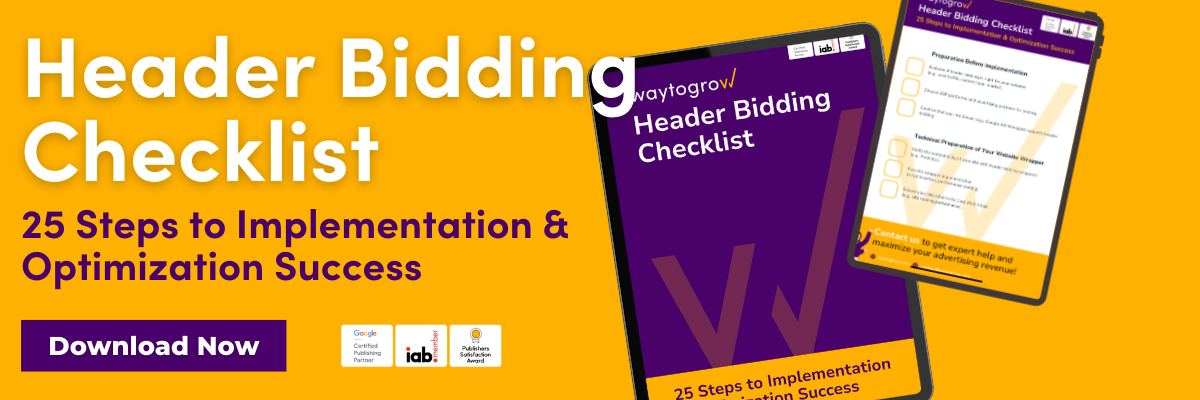Let’s imagine the World Wide Web as a bustling metropolis and your website as a prime piece of real estate in the city center. Now, imagine the ads you display as billboards on this property. The question is, where do you place these billboards to catch the most eyes and turn the highest profit? What type of billboard will fit this space? Big and bright, long and interactive or perhaps small and full of motion! The answer lies in mastering the art and science of building the perfect ad grid. As a publisher, your revenue generation potential can skyrocket if you can strategically position these “billboards” in the right spots, capturing attention and interactions without overwhelming your visitors.
The Art of Selecting Your Canvas: A Variety of Formats to Choose From
Every artist needs a canvas, and in the world of digital advertising, the canvas comes in many forms. Here are a few common ad formats that cater to diverse monetization strategies:
- Display ads: Think of these as your traditional banners ads, but on a webpage. These ads can be static or animated, often served through an ad network or exchange. Their positioning can significantly affect visibility and engagement.
- Video ads: Like cinema commercials, these short clips play before, during, or after a video. They are effective at promoting products or services, especially if your website leans heavily on video content.
- Native ads: These chameleons of the ad world blend seamlessly with your website’s content, making them less intrusive than traditional display ads. They often come in the form of sponsored content, recommendations, or related articles.
- Pop-up ads: These ads are like surprise visitors – they pop up in a new window or tab, typically triggered by user action. While they’re high in visibility, they can also be considered intrusive and might impact the user experience negatively.
- Interstitial ads: These full-screen ads appear between pages or screens, much like a full-page ad in a magazine. They’re common in mobile apps.
A Publisher’s Masterstroke: Optimizing Ad Placements for Maximum Revenue
Once you’ve chosen your canvas, the next step is to position your ads effectively. Here are some ways to achieve that:
- Location: Just like in real estate, location is paramount for ad placements. Experiment with different locations such as the top, bottom, sidebars, or in-content to find the spots that deliver the best results. Focusing on areas of high footfall is a sure way to return dividends!
Two critical areas on a webpage, when it comes to the placement of your ads, are referred to as “Above the Fold” and “Below the Fold”.
“Above the Fold” refers to the section of the webpage that a viewer sees first, without scrolling. This prime digital real estate is often the most valuable area for ad placement. Ads positioned here tend to be the most effective and generate the highest CPMs (Cost Per Mille or Cost Per Thousand Impressions) due to their excellent viewability and immediate impact upon page loading.
On the other hand, “Below the Fold” refers to the area that becomes visible only once the user starts scrolling down the webpage. As the user scrolls, the value of the ad placement typically decreases, as ads in these areas can become less impactful, due to decreased visibility and attention.
Experiment with different locations such as the top, bottom, sidebars, or in-content, and especially the “Above the Fold” and “Below the Fold” areas, to find the spots that deliver the best results.
- Size and Format: Bigger can often be better in advertising, and engaging formats like video or native ads tend to capture users’ attention more effectively.
- Frequency: It’s all about balance here. You want to ensure your ads are seen, but without overexposing them and risking ad fatigue. Too much and and you can be subject to unwanted attention by the regulatory bodies.
The Fine Balance: Best Practices for Successful Ad Grid Development
Remember, success in ad placements comes from striking the right balance. Here are a couple of guidelines:
- Relevance: Your ads should harmonize with the content on your website or app. Displaying irrelevant ads might disrupt the user experience and increase bounce rates.
- Balance: This is where the artistry comes in. Balancing between monetization and user experience is critical. Overloading your website with ads could deter users from visiting your site in the future.
Did you know?
Waytogrow’s strategy enhances ad impressions without overloading websites, by adhering to Google and IAB policy guidelines and leveraging features like “reload”, “lazy loading” and “Sticky” features. This approach optimizes ads placement and maximizes impact, balancing revenue growth with a quality user experience.
As you navigate the expanse of your digital inventory , always consider your content type and audience. For example, if your website has a vast repository of video content, video ads would likely be your go-to choice or perhaps your articles are long and highly engaging then a smart engine might be your muse!
The Final Brushstroke: Understanding Ad Placements
In the grand mural of digital advertising, understanding ad placements, effectively optimizing them, and maintaining a balance between monetization and user experience is the key to maximizing your revenue as a publisher. So, wield your artist’s palette with confidence, and remember, every well-placed ad is a potential stroke of genius that could turn the page to profitability and the next programmatic masterpiece!
Share on:










